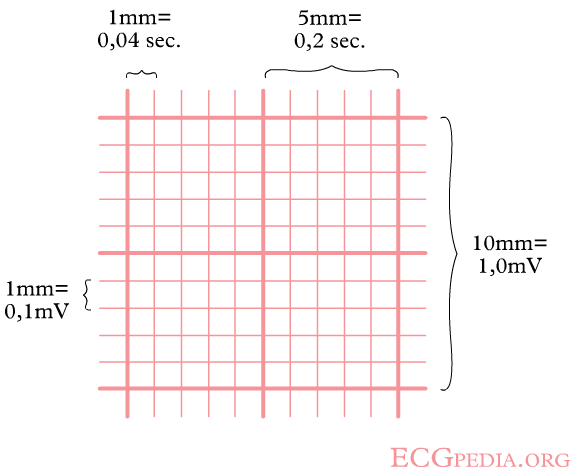Rate: Difference between revisions
Jump to navigation
Jump to search
No edit summary |
No edit summary |
||
| Line 2: | Line 2: | ||
==What is the cardiac frequency?== | ==What is the cardiac frequency?== | ||
[[Image:ECGpapier.png|thumb| The width of a square on the ECG represents time]] | [[Image:ECGpapier.png|thumb| The width of a square on the ECG represents time]] | ||
[[Image:Ecgfreq.png|thumb| | [[Image:Ecgfreq.png|thumb| The countmethod to determine the heartfrequency. The second QRS-complex is between ''75'' and ''60'' beat per minute. This heartbeat is between that, around 65 beats per minute.]] | ||
To | To anwer this question, determine the time between two QRS complexes. Previously, the ECG was registered on a paperstrip transported through an ECG writer at the speed of 25 mm/second. Nowadays, digital ECG registration is common however, the method of determining the frequency remains the same. The ECG paper has a grid with thick lines 5 mm apart (= 0,20 second) and thin lines 1 mm (0,04 second). | ||
'''There are three simple methods to determine the hart frquency (HF):''' | '''There are three simple methods to determine the hart frquency (HF):''' | ||
# Count the small (1mm) lines between two QRS-complexes. | # Count the small (1mm) lines between two QRS-complexes. Hense, the ECG paper runs with 25 mm/sec through the ECG writer, therefore: [[Image:HFformule.png]]This method works fine in case of tacycardia (>100 beats/minute)<br> | ||
# To determine the frequency of a normal sinus ritme: Use the sequence 300-150-100-75-60-50-43-37. Count from the first QRS complex, the first thick line is 300, the next line 150 etc. Stop the sequence at the next QRS complex. When the second QRS complex is in between two lines, take the mean of the two numbers from the sequence. You can finetune this method with the following more precise sequence: | # To determine the frequency of a normal sinus ritme: Use the sequence 300-150-100-75-60-50-43-37. Count from the first QRS complex, the first thick line is 300, the next line 150 etc. Stop the sequence at the next QRS complex. When the second QRS complex is in between two lines, take the mean of the two numbers from the sequence. You can finetune this method with the following more precise sequence: | ||
*'''300'''''-250-214-187-167-'''''150''' | *'''300'''''-250-214-187-167-'''''150''' | ||
| Line 15: | Line 15: | ||
*'''75'''''-71-68-65-62-'''''60''' | *'''75'''''-71-68-65-62-'''''60''' | ||
# Non regular | # Non regular rhytms are best determined with the "3 second marker method" Count the number of QRS-complexes that fit in 3 seconds (some ECG writers register this period on the ECG paper). Multiply this number by 20 and find the number of beats/minute. | ||
{{clr}} | {{clr}} | ||
Revision as of 14:35, 6 May 2007
Some statements may be disputed, incorrect or biased. |
What is the cardiac frequency?


To anwer this question, determine the time between two QRS complexes. Previously, the ECG was registered on a paperstrip transported through an ECG writer at the speed of 25 mm/second. Nowadays, digital ECG registration is common however, the method of determining the frequency remains the same. The ECG paper has a grid with thick lines 5 mm apart (= 0,20 second) and thin lines 1 mm (0,04 second).
There are three simple methods to determine the hart frquency (HF):
- Count the small (1mm) lines between two QRS-complexes. Hense, the ECG paper runs with 25 mm/sec through the ECG writer, therefore:
 This method works fine in case of tacycardia (>100 beats/minute)
This method works fine in case of tacycardia (>100 beats/minute) - To determine the frequency of a normal sinus ritme: Use the sequence 300-150-100-75-60-50-43-37. Count from the first QRS complex, the first thick line is 300, the next line 150 etc. Stop the sequence at the next QRS complex. When the second QRS complex is in between two lines, take the mean of the two numbers from the sequence. You can finetune this method with the following more precise sequence:
- 300-250-214-187-167-150
- 150-136-125-115-107-100
- 100-94-88-83-79-75
- 75-71-68-65-62-60
- Non regular rhytms are best determined with the "3 second marker method" Count the number of QRS-complexes that fit in 3 seconds (some ECG writers register this period on the ECG paper). Multiply this number by 20 and find the number of beats/minute.
What changes the frequency of the heart?
A number of factors change the heart frequency including:
- the (para) sympathic nerve system.
- The sympathic system e.g. epinephrin (=adrenalin) increases the atrioventricular conduction and contractility. (the fight, fright, flight reaction)
- Het parasympathic system (nervus vagus) e.g. acetycholin decreases the frequency and atrioventricular conduction. The parasympathic system effects mainly the atria.
- De filling of the heart. Cardiac filling increases the frequency.